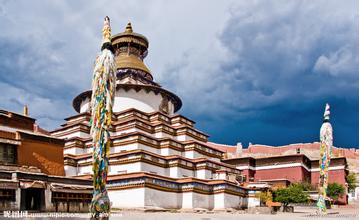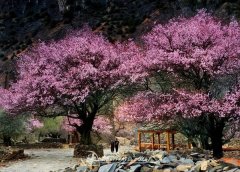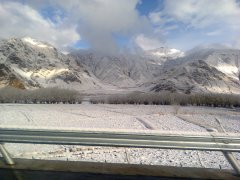
A brief introduction of Kumbum Monastery

in front of temple Kumbum
The sight is most sacred due to the personages who have graced it with their presence. It was originally built upon the birth place of the founder of the Gelukpa Sect (Yellow Hat) of Tibetan Buddhism, Tsong Khapa. Two of his disciples from this region also went on to become famous in the Buddhist world, one becoming Dalai Lama, the other the Panchen Lama, both great living Buddhas. The present Dalai Lama, now in exile in India, also studied and lived here.
Constructed on a slight mountain slope on the edge of a wide valley, the monastery consists of a number of different prayer halls, an exhibition hall, the monk's dormitories and various pagodas. There are a total of around 20,000 religious paintings and embroideries within, as well as numerous yak butter sculptures and idols of Buddhas past, present and future. Despite the destructive climate and an earthquake in 1990, the monastery has been well preserved in parts, and well restored in the rest. In total the walled monastery covers about a quarter of a mile squared, making it hard to cover all of the sights within and nearby in one, or even two, days.
There are a number of highlights however that should make it easier for you to select where to see. The most interesting are listed below, but of the others, worth a visit include the Propitious Pagoda (Ruyi baota), the Peace Pagoda (Taiping tai) and the Buddha Pagoda (Puti ta). A quick detour will take you to the Kitchens (Chu fang), where 3 huge bronze cauldrons are kept to feed the temple masses (now the resident monks number around 600). The area around the monastery is also worth spending a bit of time in, a valley of fields, with mountains in the distance, that is nice for hiking. From here you can view the pilgrims who devoutly circle the monastery with plodding, praying steps.
The Great Hall of the Golden Roof (Da jinwa si) is a large building containing a number of murals depicting scenes from Buddha's life, and a silver stuppa within which is contained a statue of Tsong Khappa.
The Lesser Hall of the Golden Roof (Xiao jinwa si) is a temple for lovers of taxidermy, containing within its walls some well-preserved stuffed specimens of bulls, antelopes, bears and monkeys, and a white horse, which is said to have taken the ninth Panchen Lama from Tibet to Qinghai within one day.
The Great Hall of Meditation (Da xingtang) is a large, dark prayer hall that contains dozens of hanging silk tapestries and thickly carpeted pillars.
The Hall of Butter Sculptures (Suyou hua tang) contains many of the famous yak butter sculptures. This art has existed for many hundreds of years, originally coming from Tibet to Kumbum in the sixteenth century. The better of the sculptures are put on display during the Lantern Festival (Yak Butter Lamp Festival, see below).
The First Two Halls contain many imposing statues, carvings (on their huge supporting poles), silk embroidery works and gold-, silver- and copper-ware.
Special attention: Photography is prohibited within the monastery.
How to get there: To go to the monastery, you can take a mini bus to nearby Huangzhong (RMB5, leaves every 30mins, takes 30mins) from the west entrance of the Xining City Gymnasium (Xining tiyuguan), at Dashizi in the western part of Xining (from the railway station, take bus No.1 for seven stops). The bus drops passengers off at the Huangzhong bus station, about 20 minutes' walk uphill to the main gate of the monastery. To go back, you may head to the Huangzhong town square, where buses back to the city are available until 6pm.
Lodging and dining: There are basically two options for those who wish to stay the night here. The first is the small Pilgrim's Hostel in the monastery itself, a really ancient old building with ancient (and cheap) facilities to match. The second is with the two star Ta'er Hotel (Ta'er binguan, Tel: 0972-232452) at 57 Yingbin lu, just to the left of the main monastery gate as you face it before entering. Triples here will set you back around RMB55/bed or RMB180 for a double room (negotiable!). For dining there is a restaurant in the Pilgrim's Hostel, or a few places down in the town. All serve standard Muslim food.
Opening hours: 8am-5pm.

With exceptional passion and outstanding leadership, Mrs. Catherine has dedicated herself to Tibet inbound tourism and China tour for 15 years. As one of the handful females who see great potential of Chinese inbound tourism, Catherine has made great contribution to promoting Tibet tourism and enhancing the employment of Tibetans and prosperity of local Tibetan community.
Over the years, she travelled overseas with Tibet Tourism Bureau many times to promote Tibet tourism. Currently, Catherine works as the marketing director of Tibet Vista, an opinion leader behind the whole team of Tibet Vista.
Related Articles & Posts

Latest Tibet Travel News

Tibet Vista: A Social Responsible Tour Organizer
Aug 14,2023

Tibetan Monks Debate in Drepung Monastery
Jun 10,2023

Tips for Traveling to Tibet in Spring
Feb 17,2022

Snow Will Hit Qinghai-Tibet Plateau
Feb 17,2022


.jpg)




0 Comment ON "A brief introduction of Kumbum Monastery"